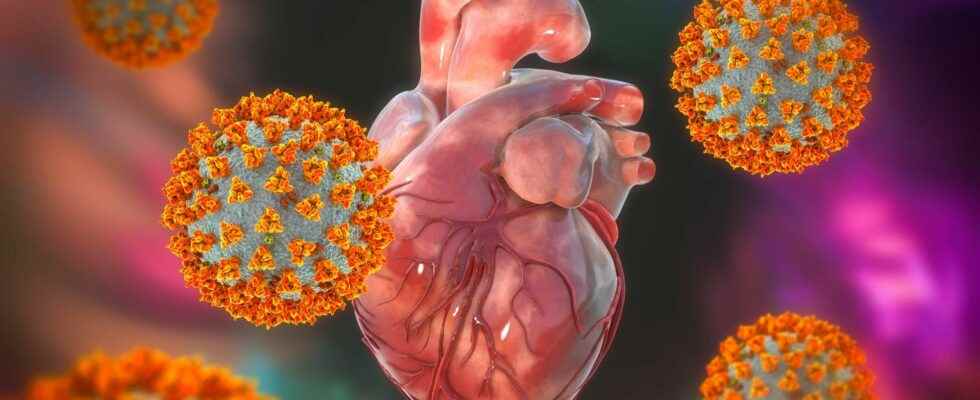You will also be interested
[EN VIDÉO] Where does SARS-CoV-2 really come from? Almost two years after the start of the Covid epidemic, the exact origin of the SARS-CoV-2 virus is still unknown.
Fulminant myocarditis is a rare sickness and serious affecting mainly young individuals. She is responsible for a inflammation and myocardial dysfunction associated with significant mortality. virus infection SARS-CoV-2 can lead to fulminant myocarditis, most often integrating into a syndrome multisystemic inflammatory disease, initially described in children (MIS-C) then in adults (MIS-A). Recommended treatments are corticosteroids and intravenous immunoglobulins. However, some adults with fulminant myocarditis do not meet the diagnostic criteria for MIS-A established by the Center for Disease Control and Prevention (prolonged fever, rash, conjunctivitis, neurological, digestive, thrombocytopenia and marked inflammatory syndrome), suggesting that there are several phenotypes fulminant myocarditis related to Covid-19.
Under the direction of doctors Marc Pineton de Chambrun, Guillaume Hékimian and Guy Gorochov, teams from the intensive care-resuscitation department of the Pitié-Salpêtrière hospital, in collaboration with researchers from Inserm and Sorbonne University, at the Center d Immunology and Infectious Diseases (CIMI-Paris) wished better characterize fulminant myocarditis associated with SARS-CoV-2 virus infection in adults.
They conducted a retrospective study on 38 patients meeting or not meeting the MIS-A criteria admitted to critical care at the Heart Institute of La Pitié-Salpêtrière hospital for fulminant myocarditis secondary to infection with the SARS- CoV-2 between May 2020 and June 2021. The results of this study will be published on July 26, 2022 in the journal The Journal of the American College of Cardiology (JACC).
The group of patients who did not meet the criteria for MIS-A (MIS-A- group) had a more recent SARS-CoV-2 infection (median time to onset after the onset of Covid-19 symptoms: 3 days), a PCR SARS-CoV-2 more frequently positive, more serious myocarditis more frequently requiring the use of extracorporeal circulatory assistance by venoarterial ECMO (Extracorporeal Membrane Oxygenation is an assistance technique that ensures all or part of the blood circulation used in emergency) and higher hospital mortality. In the other group of patients with these criteria (MIS-A-+), heart failure occurred later (median time to onset after proven Covid-19: 32 days) and was less severe, the virus was typically undetectable. at this stage and the best prognosis.
Biomarkers to distinguish two phenotypes
These two phenotypes were also associated with different immunological profiles. Innate Responses interferon alpha (early involved in the antiviral response) and interleukin(IL)-8 (chemokine that allows the recruitment of polynuclear neutrophils) were strongly increased in MIS-A- patients, compared to MIS-A+.
MIS-A+ patients had particularly high blood levels of IL-22 and IL-17. These cytokines play an important physiological role in the barriers mucous membranes and cutaneous and are produced by the lymphocytes Th17. IL-17 is a cytokine pro-inflammatory implicated in several chronic inflammatory diseases.
In summary, MIS-A- myocarditis occurs at the same time as immune response early against replication viral. An interesting point: 54% of MIS-A- patients expressed antibody individuals (the antibody anti-RNA polymerase III), which have already been associated with recurrent viral fulminant myocarditis. In comparison, the MIS-A+ forms are associated with a specific delayed and exacerbated Th17-type lymphocyte response. The targets of this Th17 response, and the possibility of cross-reactions between virus and antigens myocardium remains to be determined.
This study therefore shows that fulminant myocarditis associated with COVID-19 represents a heterogeneous entity covering 2 patient phenotypes that differ in clinical, immunobiological and prognostic criteria. It suggests that IL-17, IL-22, interferon and anti-antibody RNA polymerase III could be used as biomarkers to distinguish these two phenotypes.
The vaccines against Covid-19 would also be associated with a risk of myocarditis and pericarditis. Even if these cardiological side effects are very rare, it would be important to determine if these biomarkers could also help to diagnose them early. Finally, IL-17 inhibitors, which are currently available on the market, seem to be an interesting therapeutic avenue in MIS-A+ patients.
Interested in what you just read?
